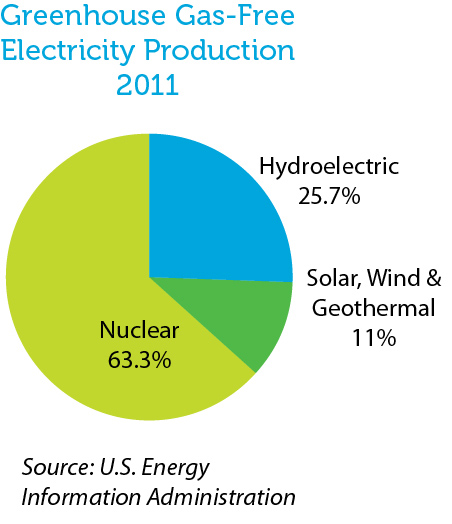The nuclear energy industry sometimes gets a bad rap. Many of the negative opinions surrounding the public’s thoughts toward nuclear power production are rooted in information that is not factual. Since nuclear energy first became a power source six decades ago, nuclear technology has made great strides and proven to be safe, affordable and environmentally friendly.
Myth: Nuclear Energy is dirty.

Nuclear energy is one of the cleanest sources of energy in the United States. Fission, the process by which nuclear energy is created, does not produce greenhouse gas. In 2011, nuclear power plants produced 63 percent of the low-carbon electricity generated in the US.
Frequently the “smoke stacks” at nuclear plants are thought to be billowing harmful emissions into the atmosphere. In fact, the white “smoke” you see rising out of nuclear plants is actually steam, and the stacks are cooling towers.
Myth: Nuclear plants emit dangerous amounts of radiation.
Radiation occurs naturally in our environment. In comparison, a person standing outside a nuclear power plant for one year will be exposed to less than one millirem (the standard unit for radiation measurement) of additional radiation. This is an extremely small amount. The EPA declares an individual is exposed to 4 millirem during a chest x-ray, anywhere from 2 to 5 millirem during a cross-country flight, and roughly 200 millirem in their home from bricks and other materials used in construction annually.
Myth: Nuclear Energy isn’t safe.
Nuclear power plants are some of the safest and most secure facilities in the United States. Statistics from the U.S. Bureau of Labor show it is safer to work at a nuclear plant than at a fast food restaurant, grocery store or in real estate.
The nuclear industry is heavily regulated to ensure the public and plant workers are kept out of harm’s way. Safety is regarded highly. After six decades of nuclear production in the U.S., there have been no radiation-related health effects linked with plant operations.
Myth: Used nuclear fuel is “waste.”
Used nuclear fuel can be recycled into new fuel and used again. Assemblies from US commercial nuclear reactors contain 90 percent of their original potential energy. According to the World Nuclear Association, the used nuclear fuel currently in storage can be recycled using existing technologies, and would produce enough energy to power the entire US fleet of more than 100 nuclear plants for over 30 years without using any new uranium.
Click here to watch a YouTube video on Nuclear Recycling: How it Works.
Myth: Nuclear power plants can explode.
You will not see a nuclear power plant erupting into a mushroom cloud. It is physically impossible for a U.S. commercial reactor to explode like a nuclear weapon. The reactor fuel does not have enough uranium to be explosive, and all reactors are built with many layers of safety controls and self-limiting features.
For example, if the reactor temperature reaches a certain level during power operations, the fission process is naturally suppressed to guarantee the power level can’t spike under any conditions. It is not possible for a person to intentionally, or unintentionally, modify a commercial nuclear reactor, its controls, or its fuel to cause an explosion.
Myth: Nuclear energy leads to the proliferation of nuclear weapons.
In order to produce nuclear weapons, highly enriched uranium or plutonium is necessary. The uranium-235 used in commercial reactors is not concentrated enough to produce nuclear weapons. The technology used to make highly concentrated uranium and plutonium for nuclear weapons is completely independent of the technology used to make uranium utilized in commercial reactors in the U.S.
Myth: No new nuclear plants have been built in the past 30 years.

Construction of nuclear plants has continued over the past 30 years. 45 reactors were put into service in the 1980s, five in the 1990s, with the last one constructed being Tennessee’s Watts Bar 1 plant in 1996. The Watts Bar 2 plant is expected to go into service in 2015. As of 2012, four new nuclear reactors were approved for construction by the Nuclear Regulatory Commission, and are currently under construction in the U.S., with many more being built across the globe.


